Biomedical Science and Research Journals | Biomechanical Principles of Multipoint Suture Fixation for Abdominal Wall Reconstruction

Biomechanical Principles of Multipoint Suture Fixation for Abdominal Wall Reconstruction Introduction In the United States, approximately 400,000 ventral hernias are repaired every year with an estimated cost of about 3 billion dollars [ 1 ] . Ventral hernias are a relatively morbid condition given that an intact abdominal wall is necessary for dynamic activities such as rotation of the torso, respiration, defecation/urination, emesis, and childbirth. The management of ventral hernias has evolved over the past several decades with advances in technology and knowledge. The first significant improvement was the use of prosthetic mesh reinforcement to simple suture repair alone [ 2 ] . As reported by Luijendijk, randomized controlled trials demonstrated a decrease in hernia recurrence rates from 43 percent to 24 percent [ 3 , 4 ]. Another major advancement was the popularization of the component separation technique as escribed by Ramirez [ 5 ] . This technique was found to be particul

